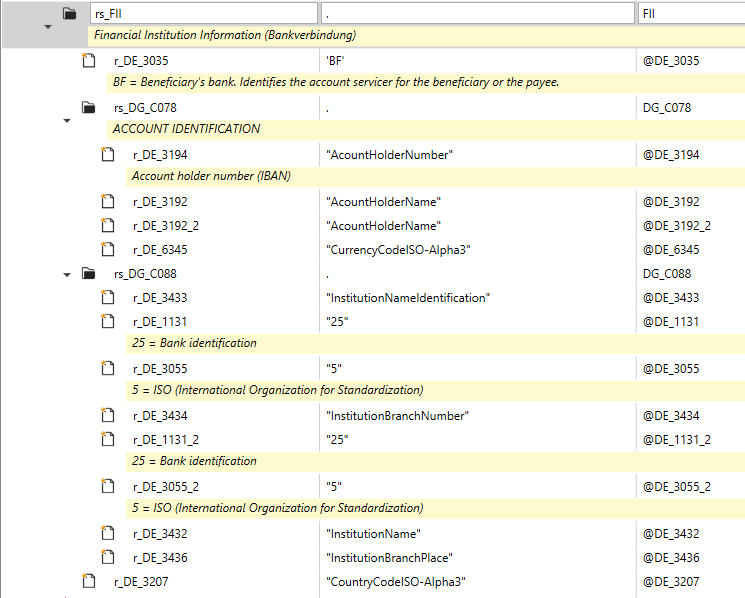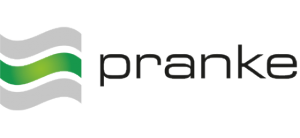No, a new regulation has been in effect since January 1, 2019, see:
Neue GTIN-Vergaberegel essentiell im Zeitalter der Digitalisierung
Sorry, this entry is only available in Deutsch.
Gemäß der ZUGFeRD-Spezifikation sind EDIFACT INVOIC mit den BGM-Qualifiern 380, 84 und 389 zulässig.
Für Pranke Elektronische Rechnung (PER) werden Gutschriften vom Typ 381 in Rechnungskorrekturen vom Typ 380 umgewandelt.
Auszug aus “Das ZUGFeRD-Format_1p0.pdf”:
891 5.1 Definierte Rechnungsarten
892 Es werden bei ZUGFeRD die folgenden Rechnungsarten unterstützt:
893 ZUGFeRD Basic
894 • Handelsrechnung (Rechnung für Waren und Dienstleistungen) mit dem Code 380
895 • Bescheide (z. B. Zahlungsaufforderung von Behörden) mit dem Code 380
896 Kaufmännische Gutschrift (z.B. Rechnungskorrektur/Storno) mit negativen Werten (Code 380)
897 In ZUGFeRD Comfort zusätzlich:
898 • Wertbelastung/Wertrechnung ohne Warenbezug (Code 84)
899 • Wertgutschrift ohne Warenbezug mit negativen Werten (Code 84)
900 In ZUGFeRD Extended zusätzlich:
901 • Selbst ausgestellte Rechnung (Steuerrechtliche Gutschrift/Gutschriftsverfahren, Code 389)
https://www.ferd-net.de/download-zugferd902 • Selbst ausgestellte Gutschrift mit negativen Werten (Code 389)
Sorry, this entry is only available in Deutsch.
Die EDIFACT Struktur sieht folgendes vor:
- GRP10(details of all package levels)
- CPS (CONSIGNMENT PACKING SEQUENCE )
- GRP11(A group of segments identifying packaging, physical dimensions, marks and numbers, quantities, date and time information, handling information and information about packing at this level. )
- PAC(PACKAGE)
- QTY(QUANTITY: A segment to specify the quantity per package described in the PAC segment.)
- GRP13(A group of segments specifying markings, labels, and packing numbers. )
- PCI(PACKAGE IDENTIFICATION: A segment specifying markings and/or labels used on individual physical units (packages) described in the PAC segment. )
- GRP14(A group of segments giving package identification numbers and, where relevant, delivery limitation information.)
- GIN(GOODS IDENTITY NUMBER: A segment providing the identity numbers of packages being despatched.)
- GRP15(A group of segments providing details of the individual despatched items.)
- LIN
- etc,
- etc
D.h. die GRP10 wird von äußerer Verpackung bis zur innersten Verpackung aufgebaut, erst dann kommen die LINs. Geschwister in der Hierarchie werden natürlich auch wiederholt und mit deren Unter-Verpackungen und LINs angegeben. Es müsste demnach etwa so aussehen:
erste Verpackungsebene
CPS+1‘
PAC+2++201‘ Anzahl Paletten
zweite Verpackungsebene
CPS+2+1‘(die erste Palette, Kind von CPS+1)
PAC+35++CT (Anzahl Kartons auf erster Palette)
GIN+AW+60101‘ Paletten Nummer
dritte Verpackungsebene
CPS+3+2‘(der erste Karton, Kind von CPS+2)
PAC+1+1:35+CT‘(1 Karton, fixe Anzahl=1)
QTY+52:32:PCE‘ Anzahl der Artikel im Karton
PCI+33E‘
GIN+BJ+7714‘ Kartonnummer
LIN+11++8436037080616:EN‘ Erster Artikel aus Karton 7714
.
.
.
LIN+11++8436037080617:EN‘ Zweiter Artikel aus Karton 7714
CPS+4+2‘(der zweite Karton, Kind von CPS+2)
PAC+1+1:35+CT‘(1 Karton, fixe Anzahl=1)
QTY+52:32:PCE‘ Anzahl der Artikel im Karton
PCI+33E‘
GIN+BJ+7715‘ Kartonnummer
LIN+11++8436037080616:EN‘ Erster Artikel aus Karton 7715‘
.
.
.
LIN+11++8436037080617:EN‘ Zweiter Artikel aus Karton 7715‘
zweite Verpackungsebene
CPS+5+1‘(die zweite Palette, Kind von CPS+1)
PAC+29++CT (Anzahl Kartons auf zweiter Palette)
GIN+AW+60102‘ Paletten Nummer
dritte Verpackungsebene
CPS+6+5‘(der erste Karton, Kind von CPS+5)
PAC+1+1:35+CT‘(1 Karton, fixe Anzahl=1)
QTY+52:32:PCE‘ Anzahl der Artikel im Karton
PCI+33E‘
GIN+BJ+7716‘ Kartonnummer
LIN+11++8436037080616:EN‘ Erster Artikel aus Karton 7716
.
.
.
LIN+11++8436037080617:EN‘ Zweiter Artikel aus Karton 7716
CPS+7+5‘(der zweite Karton, Kind von CPS+5)
PAC+1+1:35+CT‘(1 Karton, fixe Anzahl=1)
QTY+52:32:PCE‘ Anzahl der Artikel im Karton
PCI+33E‘
GIN+BJ+7717‘ Kartonnummer
LIN+11++8436037080616:EN‘ Erster Artikel aus Karton 7717
.
.
.
LIN+11++8436037080617:EN‘ Zweiter Artikel aus Karton 7717
| Cross Docking | Procedure in which goods pre-picked for a final destination in a distribution warehouse are only redistributed at package level. |
| CRP program | The Cyclic Replenishment Program is a procedure for the regular replenishment of articles. |
| EAN | The international (formerly European) article number is an internationally unique article identification. |
| EANCOM | A subset of EDIFACT, carried by EAN.UCC, specifically for retail and consumer goods. |
| EAN International | The umbrella organisation for the allocation of article and company identifications looks after various standards, including EANCOM. |
| EAN.UCC | The umbrella organization of EAN International and UCC. |
| EDI | Electronic Data Interchange is a generic term for the structured exchange of data between applications. |
| EDIFACT | Electronic Data Interchange For Administration, Commerce and Transport is an internationally standardized basic standard of EDI, supported by UN and ISO. |
| GLN | The Global Location Number is an internationally unique identification of a company and is assigned by the EAN.UCC. |
| GTIN | The Global Trade Item Number is the successor of the EAN and UPC. |
| Material EDI | The profile of the DTB for data exchange between producer and supplier. |
| NCTS | The New Computerized Transit System is a computerized transit system in Europe in connection with customs. |
| PLV | The passive contract processing. |
| SSCC | The Serial Shipping Container Code is an EAN package identifier. |
| Subset | A subrange of a standard, e.g. EANCOM from EDIFACT. |
| UPC | The Universal Product Code is an equivalent of the EAN in the USA. |
| VAN | The Value added network is a value-added service, i.e. networks with additional services to the pure connection. |
| WWS profile | EANCOM application profile for lifestyle retail |
| XML/EDI | Electronic Data Interchange using eXtensible Markup Language describes electronic data interchange using XML or approaches such as ebXML, Bizztalk, but not yet a standard. |
Information on bank details can be provided in segment FII.
This is located in segment group 2 and is usually indicated after the NAD segment for the invoicing party as follows:

Financial Institution Information (Bankverbindung)
Complete Ruleset
Insert the following code via clipboard into the desired segment group 2 and add your corresponding information:
There are a number of commercial editors for EDIFACT messages. A free editor is also sufficient.
Notepad++ has proved its worth. This makes it easy to insert a line break after the segment separator to make the file easier to read.
In this case, it is preferable to record a macro inside Notepad++ that performs the search and replace of the quotation mark with quotation mark and line-switching to keyboard shortcuts.
In the FAQ How to highlight EDIFACT segments? in color is also mentioned how to highlight EDIFACT segments in color.
As a rule, the containerizer generates the UNB segment. However, if the UNB segment is to be influenced in an Edifact document, the UNB segment must be triggered in the corresponding mapping with a rule record and the desired data element must be operated with a mapping rule. The remaining UNB data elements are then created/operated by the containerizer.
The default setting of the syntax version number is 3. The EDIFACT containerizer in eBiss checks the syntax version number. If it is greater 3, the date format in the UNB segment will be adapted. In addition, a * is set in UNA segment instead of a space. Finally, you must ensure that the outgoing Edifact document corresponds to the syntax version according to ISO 9735:1998
In the requested case, you need a mapping rule like in this snapshot:

UNB Segment in mapping
For reading Edifact files, you can use the free editor Notepad++.
It supports the creation of your own language definitions.
We did this for Edifact and provide this language definition file.
DeliveryNote referes to the printed document, while Despatch Advise actually means the DESADV, which (in theory) can have a different number.
In EDIFACT these are also different RFF qualifiers, namely AAK for DESADV and DQ for DeliveryNote.


